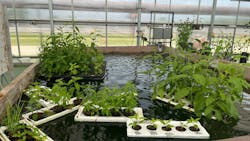MWRD studying use of floating plants for wastewater treatment
Scientists at the Metropolitan Water Reclamation District of Greater Chicago (MWRD) are assessing the potential of using plants to filter unwanted pollutants from wastewater and surface water streams, according to an MWRD press release.
The MWRD researchers at the O’Brien Water Reclamation Plant in Skokie, Illinois are studying the feasibility of phytoremediation, a process where plants are used as a tool to clean contaminated environments. Wetland plants can help prevent wind, rain, and groundwater flow from carrying contaminants away from one site to another or deeper underground, but the plants can also clean up a variety of contaminants like metals, pesticides and oil in water itself.
“We already use microorganisms for the majority of our nutrient sequestration,” said MWRD Commissioner Eira Corral Sepúlveda “It makes sense to investigate other organisms that could help with the wastewater treatment process, and at the same time, try to reduce our carbon footprint. Here we can provide multiple benefits.”
These valuable plants can also address nutrient pollution. Phytoremediation with aquatic plants or Artificial Floating Islands (AFIs) is one strategy that could be used to reduce nutrient pollution. However, more testing is needed before it is widely used. Aquatic plants can be cultivated directly in wastewater, and AFIs are hydroponic systems where wetland plants are suspended by a floating raft in wastewater. In both cases, the plants and bacterial communities attached to their roots consume phosphorus and nitrogen, resulting in cleaner water, and plant growth that can be harvested and utilized, transplanted, or kept in place.
“Phytoremediation represents a real opportunity to better manage nutrients and other forms of pollutants in water,” said MWRD President Kari K. Steele. “I applaud our Monitoring and Research Department for taking the lead on these studies that can make a broader impact on our water environment and the way we address nutrient runoff and contaminants in wastewater treatment.”
Duckweed, the smallest flowering plant known to exist, and several wetland species in AFIs can remove nitrogen and phosphorus from treated wastewater and could possibly further reduce the nutrient load to receiving waters. The next step will be to further explore at pilot scale and then scale up the technology, testing how the process could work outdoors exposed to extreme realities of the Chicago climate.
Once the field test phase is completed, a comprehensive analysis will be conducted to evaluate both its environmental impact and the practical operational considerations. This holistic assessment will provide valuable insights into the technology’s real-world potential and pave the way for its broader implementation.
